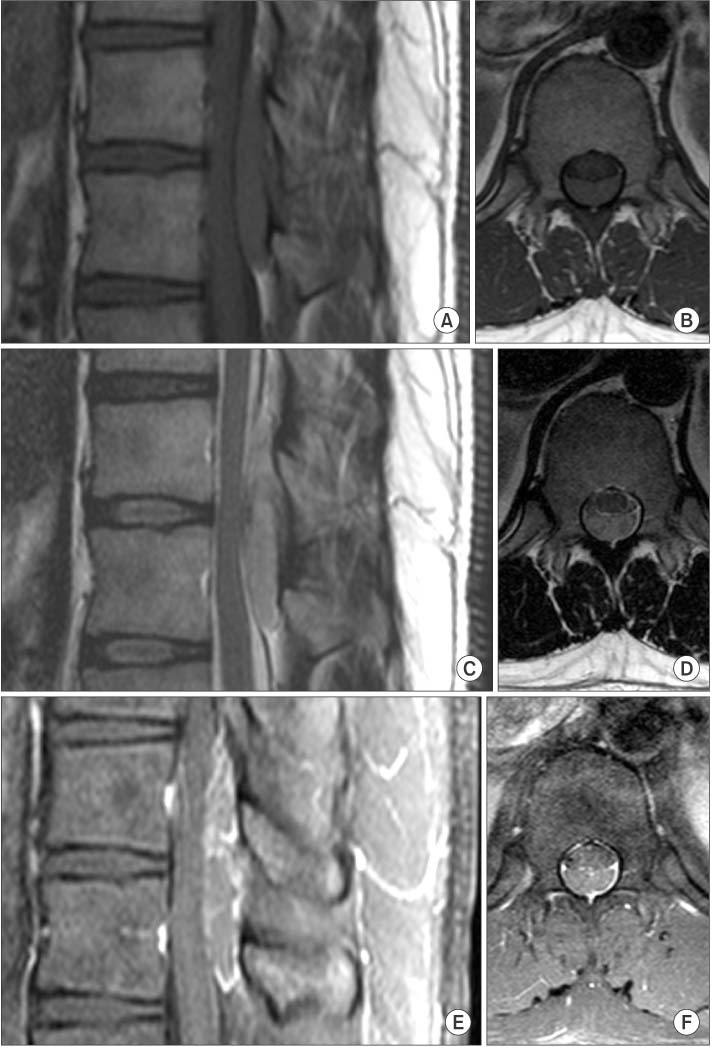J Korean Orthop Assoc.
2015 Apr;50(2):165-169. 10.4055/jkoa.2015.50.2.165.
Thoracic Epidural Cavernous Hemangioma
- Affiliations
-
- 1Department of Orthopedic Surgery, National Health Insurance Service Ilsan Hospital, Ilsan, Korea. yungspine@gmail.com
- KMID: 2106754
- DOI: http://doi.org/10.4055/jkoa.2015.50.2.165
Abstract
- A 31-year-old male presented with severe back pain and paraparesis. Imaging studies demonstrated an extraosseous, extradural mass without bone invasion at the T11-T12 vertebral level, located dorsal to the thecal sac. The spinal cord was compressed ventrally. The lesion was completely excised after a T11-T12 laminectomy. Histopathological examination revealed a cavernous hemangioma. The patient's symptoms improved after excision of the lesion.
MeSH Terms
Figure
Reference
-
1. Aoyagi N, Kojima K, Kasai H. Review of spinal epidural cavernous hemangioma. Neurol Med Chir (Tokyo). 2003; 43:471–475.
Article2. Labauge P, Bouly S, Parker F, et al. Outcome in 53 patients with spinal cord cavernomas. Surg Neurol. 2008; 70:176–181.
Article3. Caruso G, Galarza M, Borghesi I, Pozzati E, Vitale M. Acute presentation of spinal epidural cavernous angiomas: case report. Neurosurgery. 2007; 60:E575–E576.4. Feng J, Xu YK, Li L, et al. MRI diagnosis and preoperative evaluation for pure epidural cavernous hemangiomas. Neuroradiology. 2009; 51:741–747.
Article5. Hatiboglu MA, Iplikcioglu AC, Ozcan D. Epidural spinal cavernous hemangioma. Neurol Med Chir (Tokyo). 2006; 46:455–458.6. Nagi S, Megdiche H, Bouzaïdi K, et al. Imaging features of spinal epidural cavernous malformations. J Neuroradiol. 2004; 31:208–213.
Article7. Devi BI, Banerjee AK, Kak VK, Indira DB. Spinal extradural cavernous hemangioma. Neurol India. 1997; 45:38–39.8. Padovani R, Acciarri N, Giulioni M, Pantieri R, Foschini MP. Cavernous angiomas of the spinal district: surgical treatment of 11 patients. Eur Spine J. 1997; 6:298–303.
Article9. Kivelev J, Niemelä M, Hernesniemi J. Outcome after microsurgery in 14 patients with spinal cavernomas and review of the literature. J Neurosurg Spine. 2010; 13:524–534.
Article
- Full Text Links
- Actions
-
Cited
- CITED
-
- Close
- Share
- Similar articles
-
- Two Cases of Epidural Cavernous Hemangioma in the Thoraic Spine
- Spinal Epidural Cavernous Hemangioma of the Upper Thoracic Vertebrae: Case Report
- Pure Epidural Cavernous Hemangioma in Thoracic Region: A Case Report
- Thoracic Extraosseous Epidural Cavernous Hemangioma
- Pure Spinal Epidural Cavernous Hemangioma with Intralesional Hemorrhage: A Rare Cause of Thoracic Myelopathy




